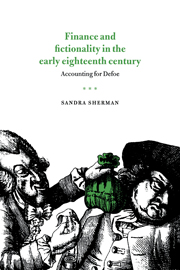3 - Credit and honesty in The Compleat English Tradesman
Published online by Cambridge University Press: 12 January 2010
Summary
CRITICAL AND GENERIC BACKGROUND
Critics do not intensively “read” The Compleat English Tradesman (1725–7) as they do Defoe's recognized “fictions.” Its appeal to economic historians apparently perpetuates a notion that its discursive constructions are unchallenging. Ironically, in view of his own treatment of the text as a post hoc primer for Roxana, Bram Dijkstra remarks that given “the largely inaccurate contention of certain Defoe scholars that he tended to contradict his own pronouncements … and was always writing on both sides of a question … many critics must have reasoned why bother to read … the more than 800 pages [actually 990] of The Compleat English Tradesman.” But it is precisely because the text is thought to lack complexity and contradiction that critics shy away! Moreover, the crux in Dijkstra's remark is the term “read.” Critics who have “bothered” relegate the text to “context” for Defoe's other work, citing its connection with Whig economics, or treating it as an example of didacticism that preceded “the rise of the novel.” Such insensitivity may reflect the text's obvious, insistent practicality and concern for arcana such as bills and notes. Curiously, critics might have been alerted to the text's relevance to fiction by Charles Lamb, who attacked it as a catalog of “the studied analysis of every mean art, every sneaking address, every trick and subterfuge (short of larceny) that is necessary in the tradesman's occupation.”
In any case, the consensus has restricted The Compleat English Tradesman to its most literal level, eliding culturally freighted discourse that deeply informs its meaning.
- Type
- Chapter
- Information
- Finance and Fictionality in the Early Eighteenth CenturyAccounting for Defoe, pp. 91 - 128Publisher: Cambridge University PressPrint publication year: 1996



